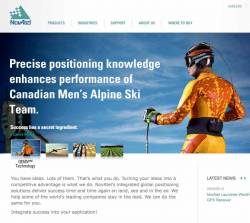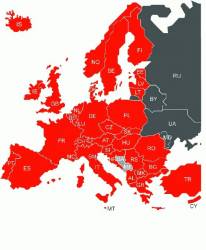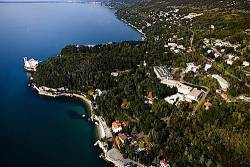 The Arthurs. Named after science fiction icon Arthur C. Clarke, the custom-designed statuettes were awarded to the top five finalists in the USA Challenge. In 1956, Clarke foresaw the development of satellite-based positioning and navigation, writing to a friend that within 30 years an “orbital relay system” could take over all existing surface [communication] networks: “ . . .three stations in the 24-hour orbit could . . . make possible a position-finding grid whereby anyone on earth could locate himself by means of a couple of dials on an instrument about the size of a watch . . . no one on the planet need ever get lost.”
The Arthurs. Named after science fiction icon Arthur C. Clarke, the custom-designed statuettes were awarded to the top five finalists in the USA Challenge. In 1956, Clarke foresaw the development of satellite-based positioning and navigation, writing to a friend that within 30 years an “orbital relay system” could take over all existing surface [communication] networks: “ . . .three stations in the 24-hour orbit could . . . make possible a position-finding grid whereby anyone on earth could locate himself by means of a couple of dials on an instrument about the size of a watch . . . no one on the planet need ever get lost.”Return to main article: "True3D HUD Wins Global SatNav Competition"
The ideas ranged from the family friendly — a smartphone app that reads historical markers and travel tidbits as you drive by — to the seriously scientific — a new secure time reference authentication method (TRANM) for GNSS receivers.
Return to main article: "True3D HUD Wins Global SatNav Competition"
The ideas ranged from the family friendly — a smartphone app that reads historical markers and travel tidbits as you drive by — to the seriously scientific — a new secure time reference authentication method (TRANM) for GNSS receivers.
Five innovative GNSS application ideas won the hearts and minds of six GNSS experts in the 2011 USA Challenge, a regional contest of the annual European Satellite Navigation Competition.
One of them, Making Virtual Solid–California’s True3D Head Up Display, went on to win the top international prize, €20,000 (US$27,800) and the Galileo Master title, at the ESNC awards ceremony in Munich, Germany in October. (MVSC received NAVTEQ’s mobile enterprise app award and placed highest in the USA Challenge, too.)
Another entry in the Final 5, TRANM, was part of a suite of innovations that won two other top prizes at the ESNC, one from DLR, the German Aerospace Center and another from the German Galileo Test and Development Environment (GATE).
The smartphone travel app, Georeader, won the “People’s Choice” award at the Institute of Navigation GNSS conference in Portland, Oregon in September.
Conference participants used the technology developed by last year’s USA Challenge winner, eVotz, to select their favorite finalist by turning their own mobile devices into secure, authenticated voting machines.
In addition to MVSC’s winning entry, here are the applications ideas that caught the eye of the USA Challenge judges:
GEOREADER
Dave Moreau, Deb Dihel, Jeff Dihel and Dan Rogas, of New York–based Social Mobility, developed this free smartphone app that allows any written text to be placed at any GPS location in the world. It starts out as a mobile travel guide, with an installed database of thousands of U.S. historical markers and other worldwide points of interest. The phone’s text-to-speech function reads the text aloud as users drive by. It’s hands free and doesn’t interfere with the phone’s GPS navigation or music players. Best of all, users can create their own 200 word messages, “Talking Points,” and can make those entries public, private or friends-only. A filter allows users to hear information only on topics of interest to them.
TRANM
Developed by Antonio Puante-Cuadrupani of PanamNav in Spain, this innovation compares signals received from GNSS satellites with a reference provided by the ground control center. From these records, the control center can calculate the corresponding combination of navigation messages at any point at any time. It issues a “Unique Signature in 4 Dimensions—US4D. This is used to authenticate the received information at each location and for a given instant. The method does not impose any requirement to the space or ground segment of the system. It can be implemented as an additional, non-interfering layer of information, similar to SBAS systems. GNSS, SBAS plus TRANM can offer position, integrity and authentication all at once.
HITCH ON
A mobile travel app idea by Shen Ge, Anish Bhattacharya, Tejal Thakore, and Neha Satak, hitch ON will offer the usual travel advice on hotels, restaurants and attractions. It differentiates itself by providing crime information and local prices without scanning barcodes. hitchON will acquire information from third-party web services, NAVTEQ maps and user-uploaded data. Information duplication will be handled through a user-rating system, which allows users to vote on the most reliable source of information. hitchON will use the PhoneGap open source framework, coded in HTML5/CSS/Javascript and will circumvent cross-platform issues between different operating systems and mobile devices.
SMPTE/GNSS
Having GNSS data available is only half the problem, says Thomas Zerucha of Ohio. How to access it or store it in a robust form can be far more difficult. Typically it is serial data and most things don’t work well with raw serial. He suggests using an existing technology, SMPTE linear time code (LTC). It has fields for hours, minutes, seconds, and frames, as well as for film, television and video. If GNSS data is merged into the user bytes of the SMPT LTC stream, digital video or audio can then incorporate contemporaneous location and velocity information.
Special Topic Prizes at ESNC
Galileo Master Awards 2011 Prizes include technology that helps cars communicate danger, collision avoidance for teeny drones, proximity-detection software for social networks, anti-spoofing and authentication technology for critical sectors, coupons that know where you go, and a GNSS-enhanced “white cane” for the blind.
In the eighth year of the Galileo Masters contest — officially the European Satellite Navigation Competition — the first permanent Galileo GNSS satellites have just gone into orbit.
But, over nearly a decade, GNSS has entered every sphere — and so has the ESNC, which started out with 14 idea submissions in 2004. This year, they welcomed satellite navigation applications ideas from 401 innovators in 49 countries, all competing for a prize pool of more than €1 million (US$1.39 million).
The ESNC organizers from Anwendungzentrum (Space Applications Center) Oberpfaffenhofen, Germany, say that one-third of the previous winners participated in incubation programs. “The fact that about 80 percent of their ideas are now being implemented proves how successful the ideas competition is in translating ideas into new businesses.”
The contest has always included special topic prizes to solve specific needs of industry. This year, eight such sponsored prizes were awarded.
POTHOLE PROTECTION
One of them, the new prototyping prize, Galileo Pro, looked for the best “connected vehicle” app. They found it in DLR’s safety application that uses on-board sensors to detect potholes and other road damage and then communicate that information to other cars on the road. The €10,000 prize came from Industrial Technology Group (ITRI) in Taiwan, which wants to incorporate next-generation GNSS into the WAVE (wireless access in vehicles) and dedicated short-range communications technologies used in intelligent vehicle systems.
AIRY AVOIDANCE
CTAE, a Catalonian aerospace research center, developed a traffic collision avoidance system for mini UAVs, weighing less than 4-1/2 pounds and unable to handle the weight of a full suite of avionics equipment. The innovation allows the UAVs to make use of data from piloted aircraft around them. The European GNSS Agency, a business development arm of the European Commission, sponsored this prize for the best use of EGNOS, the new GNSS satellite-based augmentation system.
ALWAYS CONNECT
The European Space Agency attracted nearly a quarter of the special topic submissions for its innovation prize. The winner, twofloats, tracks proximity from large numbers of moving objects. Registered users — or a trusted third party — are notified whenever another user comes close. The developers say, “You’ll never miss an opportunity to meet your future spouse.”
ANTIJAMMING
Antonio Pujante of PanamNav, the same Spanish company that made it into the USA Challenge Final Five, won two special topic prizes, both for parts of his technology package that integrates positioning, navigation, and signal authentication. The German Aerospace Center (DLR) recognized “SARA” — Signal Authentication through Receiver Autonomous techniques.
INFRASTRUCTURE PROTECTION
IFEN’s and NavCert’s GATE prize recognized “TIMEWISE,” a method that provides protection to telecommunications, energy distribution networks, and other key sectors that rely on GNSS receivers for synchronization. The prize includes three days of system experimentation at the outdoor Galileo test range (GATE) in Bavaria.
WATCHFUL COUPON
A European Union series of projects called GNSS Living Labs awarded their €10,000 prize to Geo-Coupon, an idea from Taiwan’s ITRI. It’s a limited-duration digital coupon that monitors the actions the user must take in order to realize the worth of the coupon — for example, number of visits to a certain store.
VIRTUAL SIGHT
Two graduate students from Karlsruhe Institute of Technology developed an idea for a device that would give true independence to the vision impaired — a virtual “white cane.” They intend to use Galileo’s accuracy for an integrated image-processing unit that combines indoor and outdoor navigation. Their idea snared the ESNC University Challenge Prize in location-based services.





